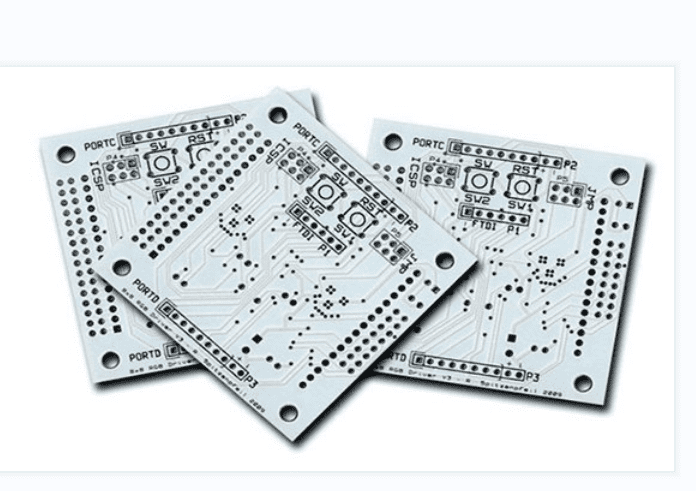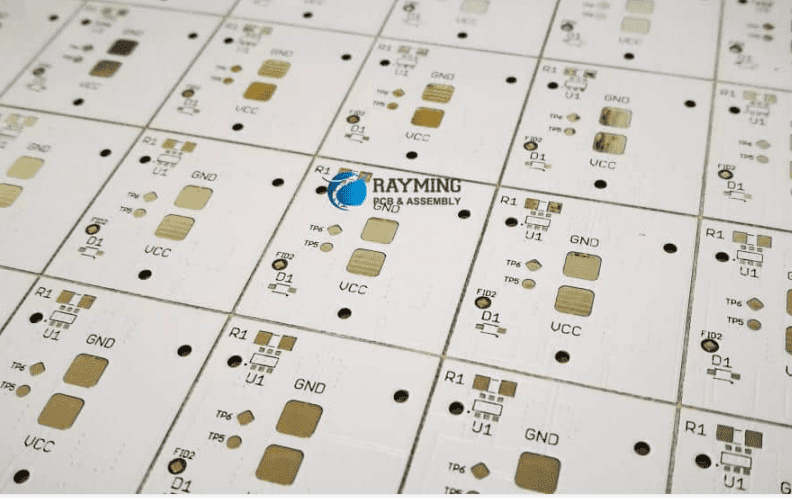Does the color of a Printed Circuit Board (PCB) have any role to play in how the board turns out to function? It appears that the properties are much more than the color, as we can see in white PCB.
In this article, we explain the concept behind the whitish color of a Printed Circuit Board (PCB).
What is a White PCB?
Ordinarily, you will say that it is a “PCB with a white color.” While that is not entirely wrong, there is more to it than just that.
A white Printed Circuit Board or White PCB for short, refers to the circuit board that has the solder mask comprised more of the white concentration. As you may know, the solder mask is one of the core attributes and as PCBasic noted, the “PCB color” generally refers to the oil color on the board.

Now, the color of the PCB is usually derived from the color of the solder resist, which is the hardened resin containing pigments, and which is died to the Printed Circuit Board (PCB).
While it is common for most PCBs to have the green solder mask or color, it is also possible for the boards to use other colors. The popular PCB colors range from black, purple, blue, yellow, brown, red and green. In recent times, it has become a thing for PCB manufacturing companies to also make white PCBs, as well as pink-colored circuit boards.
Why White PCB is Becoming Popular
Now that we have demystified the fact that not all PCBs have a green solder mask or green color, let us now see some of the reasons why using the white PCB is better.
1. Excellent Electricity Transfer or Reflections
It is common to use the white PCBs, with the Light Emitting Diode (LED) systems or applications. The reason is not far-fetched from the fact that these LED systems deal more with lights, and as such, require a corresponding solder mask that makes the lights more reflective.
The white PCBs meet that need, as they provide convenient electricity transfer, which, in turn, leads to the improved emissions of brighter lights.
2. Excellent Component Positioning
It is said that the white PCBs take more components, in addition to having these components soldered on the PCB board that is based on a circuit.
White PCBs and the LED Market
White Printed Circuit Boards (PCBs) are ideal for use in the Light Emitting Diode (LED) applications for one reason – those applications need to bring forth the best lighting solutions as possible.
Therefore, it is because of the reflective nature of the white PCB that it is prioritized for this purpose. With the white PCB, it becomes possible for the lighting solutions emitting from LED systems to be conveyed in the same way as they come forth.

However, the usage of the white PCBs in the LED market might come with some trade-offs. For example, the PCB works best with certain applications than it does with others. Therefore, to get the best results, make sure to inform the white PCB manufacturer of the type of LED system to use the circuit board to get the best deal.
Downsides to Working with White PCBs
If you are choosing a PCB with white solder mask, you have to be sure of the applications to avoid making a bad investment. The reason is not far from the fact that white PCBs can sometimes, be a bad investment, depending on the applications.
A notable downside is the increased chances of the deposit of the whitish residues on the surface of the PCB.
The following are some of the additional downsides or disadvantages of prioritizing the white PCB solder mask over the other types of solder masks:
Extra Care and Precautions
You need to pay more attention to the surface of your white PCB, than you would have paid to the surface of other PCB solder masks.
This is partly because the white solder mask tends to hide some residues, thereby making it more difficult to clean and mainly because of the fact that it can pose some difficulties when used with some surface finishes.
Heat Exposure
Due to the fact that PCBs dissipate a lot of heat, it becomes imperative to use a solder mask color that wouldn’t be overly exposed to heat.
That is the not the case with the white PCB, which is susceptible to heat exposure and, in the process, it tends to turn yellowish, because of the heat that comes to it.
White PCBs have Lower Contrast
One would have expected that the whitish color of the solder mask would be a good reason for the PCB to be visible.
On the contrary, white PCB has a lower contrast, because it tends to hide traces. If you want to make the most out of the visibility of a white PCB, it is best to use black screen printing. That way, you get to see a lot of the surfaces than using white throughout.

Design Iterations to Take Note of
Just as we are talking about the inability to view the white PCB’s surface, especially under direct light, it is also important to talk about some of the additional design iterations.
Here are some of the things you need to know, design-wise, before working with a white Printed Circuit Board (PCB):
White Flexible PCB
It may be wide to go for the different variations of the white PCB, one of which is the White Flexible PCB. It is ideal for use with the designing of the hardware of complex circuits.
The other attributes of the white flexible PCBs include the less weight, flexibility or adaptability to fit into various applications and the provision of reliable properties.
Silkscreen Considerations
Due to the fact that the white PCB turns yellow or light brown (depending on the heat exposure), it is imperative to choose an ideal silkscreen, such as black.
Final Words
The white PCB helps to facilitate electricity transfer, improve the light emission capabilities of LED systems and enables the soldering of the core PCB components on the circuit’s base.
Comments are closed